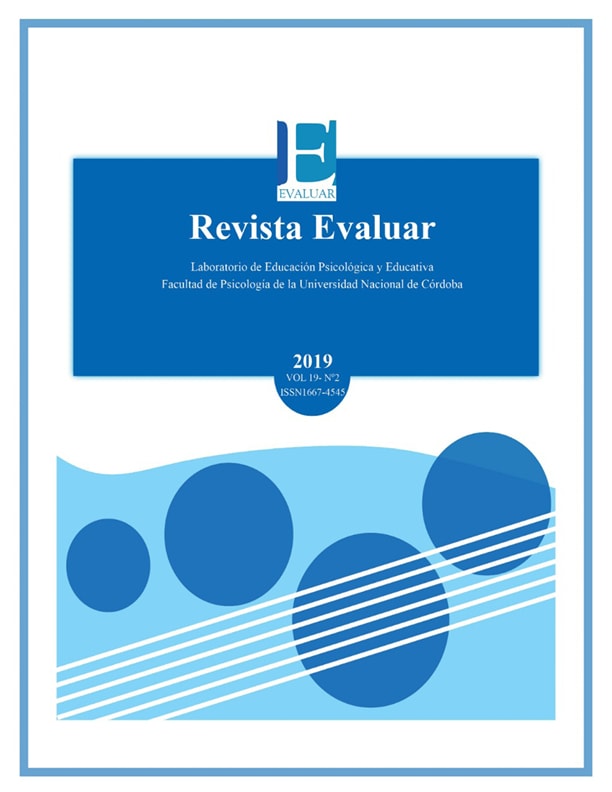Adaptation of the Children’s Test Anxiety Scale (CTAS) for its use in Argentine adolescents
DOI:
https://doi.org/10.35670/1667-4545.v19.n2.25085Keywords:
ansiedad ante exámenes, adolescentes, adaptación, análisis factorial, Children’s Test Anxiety Scale (CTAS)Abstract
The Children’s Test Anxiety Scale (CTAS; Wren & Benson, 2004) was adapted to Spanish for its use in adolescents (12 - 17 years old) from Argentina. CTAS is a self report with 30 items grouped in 3 factors named: task off be-haviours, thoughts and autonomic reactions. The items were directly translated into Spanish, and an equivalence analysis in bilingual sample was done. Two alternative solutions to internal structure of the CTAS were obtained through ex-ploratory factor analysis (N = 360 students, of both sexes, public and private schools, aged 11 to 13 years, M =12.77, SD = .72), one with three original dimensions and another with four factors, distinguishing worry and self - criticism thoughts. Both models fit was assessed through confirmato-ry factor analysis (N = 501 students, of both sexes, public and private schools, aged 12 to 17 years, M =13.98 SD = .87), having the four dimension model the most acceptable index (χ2/df = 1.92, CFI = .90, TLI = .09, RMSEA = 0.043, AIC = 410, BIC = 414), although two items were eliminated as they were considered problematic. Internal consistency of the scales was adequate (α= .68 - .79). Gender differences and correlations with academic performance were corroborated in line with other test anxiety measures. It is recom-mended to use the adapted version with some precaution.
Downloads
References
Ali, N. S. M., & Talib, R. (2015). Test anxiety in school settings: Implication on teachers. Indonesian Journal of Educational Review, 2(2), 67-75. Recuperado de http://pps.unj.ac.id/journal/ijer/index
American Psychological Association. (2017). Ethical Principles of Psychologists and Code of Conduct. Recuperado de http://www.apa.org/ethics/code/index.aspx
Axelsson, L., & Ejlertsson, G. (2002). Self-reported health, self-esteem and social support among young unemployed people: A population-based study. International Journal of Social Welfare, 11(2), 111-119. doi: 10.1111/1468-2397.00205
Aydin, U., & Bulgan, G. (2017). Çocuklarda S?nav Kayg?s? Ölçe?i’nin Türkçe Uyarlamas?. Ilkö?retim Online, 16(2), 887-899. doi: 10.17051/ilkonline.2017.304742
Bagley, C., & Mallick, K. (2001). Normative data and mental health construct validity for the Rosenberg Self-Esteem Scale in British adolescents. International Journal of Adolescence and Youth, 9(2-3), 117-126. doi: 10.1080/02673843.2001.9747871
Bauermeister, J., Collazo, J., & Spielberger, C. (1983). The construction and validation of the Spanish form of the Test Anxiety Inventory: Inventario de Auto Evaluación sobre Exámenes (IDASE). En C. D. Spielberger & R. Diaz Guerrero (Eds.). Cross-cultural Anxiety (pp. 67-85). Washington: McGraw-Hill
Browne, M. W., & Cudeck, R. (1993). Alternative ways of assessing model fit. En: K. A. Bollen & J. S. Long (Eds.), Testing structural equation models (pp. 136-162). Beverly Hills, CA: Sage.
Carsley, D., & Heath, N. L. (2019). Evaluating the effectiveness of a mindfulness coloring activity for test anxiety in children. The Journal of Educational Research, 112(2), 143-151. doi: 10.1080/00220671.2018.1448749
Cassady, J. C. (2004). The impact of cognitive test anxiety on text comprehension and recall in the absence of external evaluative pressure. Applied Cognitive Psychology, 18(3), 311-325. doi: 10.1002/acp.968
Cassady, J. C., & Johnson, R. E. (2002). Cognitive test anxiety and academic performance. Contemporary Educational Psychology, 27(2), 270-295. doi: 10.1006/ceps.2001.1094
Cattell, R. B. (1966). The scree test for the number of factors. Multivariate Behavioral Research, 1(2), 245-276. doi: 10.1207/s15327906mbr0102_10
Cizek, G. J., & Burg, S. S. (2006). Addressing test anxiety in a high-stakes environment: Strategies for classrooms and schools. Thousand Oaks, CA: Corwin.
Eum, K., & Rice, K. G. (2011). Test anxiety, perfectionism, goal orientation, and academic performance. Anxiety, Stress, & Coping, 24(2), 167-178. doi: 10.1080/10615806.2010.488723
Furlan, L. (2006). Ansiedad ante los exámenes. Qué se evalúa y cómo? Evaluar, 6, 32-51. Recuperado de https://revistas.unc.edu.ar/index.php/revaluar
Furlan, L. (2013). Eficacia de una intervención para disminuir la ansiedad frente a los exámenes en estudiantes universitarios argentinos. Revista Colombiana de Psicología, 2(1), 75-89. doi: 10.15446/rcp
Furlan, L. A., Cassady, J. C., & Pérez, E. R. (2009). Adapting the Cognitive Test Anxiety Scale for use with Argentinean university students. International Journal of Testing, 9(1), 3-19. doi: 10.1080/15305050902733448
Furlan, L. A., Ferrero, M. J., & Gallart, G. (2014). Ansiedad frente a los exámenes, procrastinación y síntomas mentales en estudiantes universitarios. Revista Argentina de Ciencias del Comportamiento, 6(3), 31-39. Recuperado de https://revistas.unc.edu.ar/index.php/racc
George, D., & Mallery, P. (2010). SPSS for Windows step by step: A simple guide and reference, 17.0 Update (10a ed.). Boston, MA: Pearson.
Gutiérrez-Calvo, M. (1996). Ansiedad y deterioro cognitivo: Incidencia en el rendimiento académico. Ansiedad y Estrés, 2(2-3), 173-194. Recuperado de https://dialnet.unirioja.es
Hair, J. F. J., Anderson, R. E., Tatham, R. L., & Black, W. C. (1995). Multivariate data analysis (4a ed.). Saddle River, NJ: Prentice Hall.
Hembree, R. (1988). Correlates, causes, effects, and treatment of test anxiety. Review of Educational Research, 58(1), 47-77. doi: 10.2307/1170348
Heredia, D., Piemontesi, S., Furlan, L., & Hodapp, V. (2008). Adaptación del Inventario Alemán de Ansiedad frente a los Exámenes: GTAI-A. Revista Evaluar, 8(1), 46-60. Recuperado de https://revistas.unc.edu.ar/index.php/revaluar
Hodapp, V. (1995). The TAI-G: A multidimensional approach to the assessment of test anxiety. En C. Schwarzer & M. Zeidner (Eds.), Stress, Anxiety, and Coping in Academic Settings, (pp. 95-130). Francke, Tübingen.
Horn, J. L. (1965). A rationale and test for the number of factors in factor analysis. Psychometrika, 30(2), 179-185. doi: 10.1007/bf02289447
IBM Corporation. (2016). IBM SPSS Statistics for Windows, Version 24.0 [software de cómputo]. Armonk, NY: IBM.
Kessler, R. C., Sonnega, A., Bromet, E., Hughes, M., & Nelson, C. B. (1995). Posttraumatic stress disorder in the national comorbidity survey. Archives of General Psychiatry, 52, 1048-1060.
La Greca, A. M. E., Siegel, L. J., Wallander, J. L., & Walker, C. (1992). Stress and coping in child health. Nueva York, NY: Guilford.
Liebert, R. M., & Morris, L. W. (1967). Cognitive and emotional components of test anxiety: A distinction and some initial data. Psychological Reports, 20(3), 975-978. doi: 10.2466/pr0.1967.20.3.975
Lowe, P. A., & Lee, S. W. (2008). Factor structure of the Test Anxiety Inventory for Children and Adolescents (TAICA) scores across gender among students in elementary and secondary school settings. Journal of Psychoeducational Assessment, 26(3), 231-246. doi: 10.1177/0734282907303773
Montero, I., & León, O. G. (2002). Clasificación y descripción de las metodologías de investigación en Psicología. International Journal of Clinical and Health Psychology, 2(3), 503-508. Recuperado de http://www.aepc.es/ijchp/busca.php?coid=Espa%F1ol
Muthén, L. K., & Muthén, B. O. (1998-2015). Mplus User’s Guide (7a ed.). Los Angeles, CA: Muthén & Muthén.
Nyroos, M., Korhonen, J., Linnanmäki, K., & Svens-Liavåg, C. (2012). A cross-national comparison of test anxiety in Swedish and Finnish grade 3 pupils: Measured by the CTAS. Education Inquiry, 3(4), 615-636. doi: 10.3402/edui.v3i4.22057
Nyroos, M., & Wiklund-Hörnqvist, C. (2011). Introducing national test in Swedish primary education: Implications for test anxiety. Electronic Journal of Research in Educational Psychology, 9(25), 995-1022. doi: 10.25115/ejrep.v9i25.1466
Piemontesi, S., Heredia, D., & Furlan, L. (2009). Correlatos de la ansiedad ante los exámenes: Una aproximación a la teoría de la reducción en la eficiencia. Revista Tesis, 2, 74-86. Recuperado de https://revistas.unc.edu.ar/index.php/tesis
Piemontesi, S., Heredia, D., & Furlan, L. (2012). Propiedades psicométricas de la versión en español revisada del Inventario Alemán de Ansiedad ante Exámenes (GTAI-AR) en estudiantes argentinos. Universitas Psychologica, 11(1), 177-186.
Piemontesi, S., Heredia, D., Furlan, L., Sánchez, J., & Martínez, M. (2012). Ansiedad ante los exámenes y estilos de afrontamiento ante el estrés académico en estudiantes universitarios. Anales de Psicología, 28(1), 89-96.
Sarason, I. G. (1984). Stress, anxiety, and cognitive interference: Reactions to tests. Journal of Personality and Social Psychology, 46, 929-938.
Sarason, S. B., Davidson, K. S., Lighthall, F. F., Waite, R. R., & Ruebush, B. K. (1960). Anxiety in elementary school children: A report of research. Hoboken, NJ: John Wiley & Sons. doi: 10.1037/14349-000
Segool, N. K., Carlson, J. S., Goforth, A. N., von der Embse, N., & Barterian, J. A. (2013). Heightened test anxiety among young children: Elementary school students’ anxious responses to high-stakes testing. Psychology in the Schools, 50(5), 489-499. doi: 10.1002/pits.21689
Servera, M.; Llabrés, J., & Bornás, X. (1996). Prevención de la ansiedad en escolares. Ansiedad y Estrés, 2(2-3), 283-295.
Spielberger, C. D. (1966). Theory and research in anxiety. En C. D. Spielberger (Ed.), Anxiety and Behavior (pp. 3-20). Nueva York, NY: Academic. doi: 10.1016/b978-1-4832-3131-0.50006-8
Tabachnick, B., & Fidell, L. (2001). Using multivariate statistics (4a ed.). Boston: Allyn and Bacon.
Thomas, C. L., Cassady, J. C., & Heller, M. L. (2017). The influence of emotional intelligence, cognitive test anxiety, and coping strategies on undergraduate academic performance. Learning and Individual Differences, 55, 40-48. doi: 10.1016/j.lindif.2017.03.001
Von der Embse, N., Barterian, J., & Segool, N. (2013). Test anxiety interventions for children and adolescents: A systematic review of treatment studies from 2000-2010. Psychology in the Schools, 50(1), 57-71. doi: 10.1002/pits.21660
Von der Embse, N., & Hasson, R. (2012). Test anxiety and high-stakes test performance between school settings: Implications for educators. Preventing school failure: Alternative Education for Children and Youth, 56(3), 180-187. doi: 10.1080/1045988X.2011.633285
Wren, D. G., & Benson, J. (2004). Measuring test anxiety in children: Scale development and internal construct validation. Anxiety, Stress, & Coping, 17(3), 227-240. doi: 10.1080/10615800412331292606
Zeidner, M. (1998). Test anxiety: The state of the art. Nueva York, NY: Plenum.
Zeidner, M. (2014). Anxiety in education. En R. Pekrun & L. Linnenbrink-Garcia (Eds.), International Handbook of Emotions in Education (pp. 265-288). New York, NY: Routledge. doi: 10.4324/9780203148211.ch14
Downloads
Published
How to Cite
Issue
Section
License
Copyright (c) 2019 Natalia Belén Rivera-Flores, Luis Alberto Furlan, Gerardo Aníbal Gnavi

This work is licensed under a Creative Commons Attribution 4.0 International License.
Revista Evaluar aplica la Licencia Internacional de Atribuciones Comunes Creativas (Creative Commons Attribution License, CCAL). Bajo esta licencia, los autores retienen la propiedad de copyright de los artículos pero permiten que, sin que medie permiso de autor o editor, cualquier persona descargue y distribuya los artículos publicados en Evaluar. La única condición es que siempre y en todos los casos se cite a los autores y a la fuente original de publicación (i.e. Evaluar). El envío de artículos a Evaluar y la lectura de los mismos es totalmente gratuito.




_(3).jpg)



.jpg)



